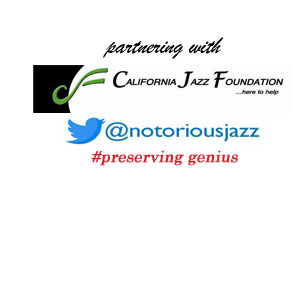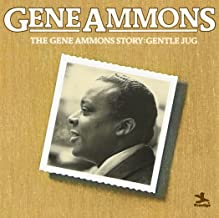
The Quarantined Jazz Voyager
The Gene Ammons Story: Gentle JugOctober 6, 1992 was the Fantasy reissued compact disc release date of the original Prestige/Moodsville Records is my next exploration into one of the world’s great bop, cool jazz, and soul-jazz tenor saxophonists to keep me company during this pandemic. The Gene Ammons Story: Gentle Jug is a compilation reissue of sixteen songs recorded on two separate dates. A master at interpreting ballads, Gene Ammons presents lyrical music that is quite enjoyable.
The album was produced and original photography taken by Esmond Edwards, recorded by Rudy Van Gelder at Van Gelder Studio in Hackensack, New Jersey, and the art direction was contributed by Phil Carroll. The reissue producer and writer of the liner notes was Bob Porter and the album was remastered by Phil De Lancie.
A compilation of two previously released albums, 1961’s Nice an’ Cool” (1 to 8) recorded on January 26, 1961, and 1962’s The Soulful Mood of Gene Ammons (9 to 16) recorded April 14, 1962. Tracks 1 to 8, originally issued on Prestige / Moodsville 18 as Gene Ammons – Nice An’ Cool Tracks 9 to 16, originally issued on Prestige / Moodsville 28 as Gene Ammons – The Soulful Moods Of Gene Ammons.
Tracklist
Nice An’ Cool
- Till There Was You (Meredith Wilson ~ 7:08
- Answer Me, My Love (Rauch, Winkler) ~ 4:35
- Willow Weep For Me (Ann Ronell) ~ 4:00
- Little Girl Blue (Richard Rodgers, Lorenz Hart) ~ 4:55
- Something I Dreamed Last Night (Magidson, Yellen, Fain) ~ 7:41
- Something Wonderful (Riodgers, Hammerstein) ~ 3:03
- I Remember You (Mercer, Schertzinger) ~ 4:21
- Someone To Watch Over Me (Gershwin, Gershwin) ~ 3:48
- Two Different Worlds (Frisch, Wayne) ~ 4:53
- But Beautiful (Burke, Van Heusen) ~ 4:27
- Skylark (Carmichael, Mercer) ~ 6:19
- Three Little Words (Kalmar, Ruby) ~ 3:49
- On The Street Of Dreams (Lewis, Young) ~ 3:09
- You’d Be So Nice To Come Home (Cole Porter) ~ 4:17
- Under A Blanket Of Blue (Neiburg, Livington, Symes) ~ 5:12
- I’m Glad There’s You (Dorsey, Mertz) ~ 6:02
- Gene Ammons ~ Tenor Saxophone
- Patti Bown (tracks: 9 to 16) | Richard Wyands (tracks: 1 to 8) ~ Piano
- Doug Watkins (tracks: 1 to 8) | George Duvivier (tracks: 9 to 16) ~ Bass
- Ed Shaughnessy (tracks: 9 to 16) | J.C. Heard (tracks: 1 to 8) ~ Drums
When the curtain goes up and the pandemic is controlled I will return to flying around the globe discovering the best of jazz. Until that time arrives stay safe and healthy.
More Posts: adventure,club,genius,jazz,museum,music,preserving,restaurant,saxophone,travel
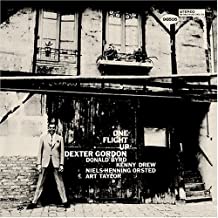
Requisites
One Flight Up ~ Dexter Gordon | By Eddie Carter
This next entry from the library is an album I first heard in 1967 during one of my Saturday stops to Record Rendezvous in Cleveland, Ohio. It introduced me to tenor saxophonist Dexter Gordon who steps into the spotlight with his second LP recorded after moving abroad, One Flight Up (Blue Note BLP 4176). It follows an excellent 1963 quartet album titled Our Man In Paris. Gordon was a staple on the jazz scene since the Bebop era in the forties while a member of Billy Eckstine’s Big Band and would become a major influence for two future giants, John Coltrane, and Sonny Rollins.
He chose to move abroad because he was treated much more fairly than here in the United States and was considered an equal rather than a second-class citizen. There was also plenty of work in some of the best jazz clubs Europe and France had to offer. Dexter is assisted here by Donald Byrd on trumpet, Kenny Drew on piano, Neils-Henning Orsted Pedersen on bass, and Art Taylor on drums. My copy used in this report is the 1967 US Liberty Records Stereo reissue (BST 84176).
Side One opens with Byrd’s Tanya occupying the entire first side and giving Dexter, Donald, and Kenny plenty of solo space. The rhythm section charts its course with a brief introduction developing into a haunting theme led by both horns. Dexter works his magic on the opening chorus with nearly six-minutes of joyful bliss. Donald shows off his chops next with a brilliant-toned performance that keeps the listener’s interest throughout. Kenny turns in one of his very best performances on the finale with Neils-Henning and Art providing the articulate foundation into the out-chorus and gentle dissolve.
Side Two commences at a slightly faster beat than Tanya with Coppin’ The Haven by Drew. The trio makes a casual, laid-back introduction evolving into Byrd and Gordon’s comfortable groove on the theme. Dexter opens with a terrific performance, then Donald takes over for a reading as smooth as a sled on fresh snow. Kenny shows he’s perfectly at home on the closer with a sharp interpretation possessing a light, refreshing beat before the ensemble reassembles for the climax.
The album concludes with the 1939 standard, Darn That Dream by Jimmy Van Heusen and Eddie DeLange, introduced in the Broadway musical, Swingin’ The Dream. This is a beautiful quartet performance by Dexter and the trio who give an intimate introduction to the melody. Dexter is the centerpiece here and his lead solo is captivating. Kenny draws the listener further into the song’s spell on the closer with a tender climax.
The album was recorded by the French engineer, Jacques Lubin, and the sound quality is spectacular with a mesmerizing soundstage transporting your listening chair to the studio alongside the musicians. Gordon’s career lasted nearly forty years, making some amazing records for a host of labels including Bethlehem, Prestige, Savoy, and SteepleChase. However, it was the five years he recorded for Blue Note (1961-1966) that are among the most precious jewels in his rich discography. He passed away on April 25, 1990, at sixty-seven from kidney failure and cancer of the larynx. If you’re a fan of Dexter Gordon or Donald Byrd, I highly recommend One Flight Up by Dexter Gordon, an album I feel is an essential addition for any jazz library that you shouldn’t miss!
~ Our Man In Paris (Blue Note BLP 4146/BST 84146) – Source: Discogs.com
~ Darn That Dream – Source: JazzStandards.com ~ Dexter Gordon – Source: Wikipedia.org © 2020 by Edward Thomas Carter
More Posts: choice,classic,collectible,collector,history,instrumental,jazz,music
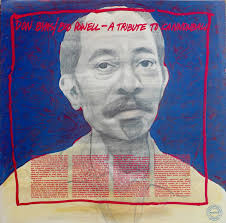
Requisites
A Tribute To Cannonball – Don Byas and Bud Powell | By Eddie Carter
This next album from the library was recorded in 1961 but remained shelved until its release in 1979, four years after the death of the musician it honors. A Tribute To Cannonball (Columbia Contemporary Master Series JC 35755) brings together Don Byas on tenor sax and Bud Powell on piano for a program of standards and two original tunes. Completing the ensemble are Idrees Sulieman (tracks: A5, B1, B2, B4) on trumpet, Pierre Michelot on bass, and Kenny Clarke on drums. My copy used in this report is the 1979 US Stereo album.
The quartet begins Side One with the Cole Porter classic, Just One of Those Things that made its debut in the 1935 musical comedy, Jubilee. The trio opens with a scintillating conversation in the opening chorus. Don adds some fierce dialogue on the second verse, then continues traveling at breakneck speed on the first solo. Bud’s nimble fingers fly over the keys at a brisk pace on the finale towards the quartet’s enthusiastic ending.
Jackie My Little Cat is a pretty ballad by Pierre Michelot that slows the tone to a softer tempo. From the first phrase of the elegantly tranquil theme, the quartet creates a warmly affectionate atmosphere for Byas who infuses the lead statement with tasteful subtlety. Powell also produces a reading of extraordinary tenderness that compliments the rhythm section’s graceful groundwork into a sensuous finale. Cherokee, also known as Indian Love Song, was written in 1938 by Ray Noble as the first movement of his five-part Indian Suite. It became a hit for bandleader Charlie Barnet in 1939 and a jazz standard after Charlie Parker’s blistering rendition in 1941 with The Kansas City Band. The song begins with a brisk duet by Don and Pierre on the introduction, then proceeds with a lightning-fast melody. Byas begins his first solo with a sizzling performance, then Powell flexes his muscles with incredible virility. The saxophonist is completely energized on the closer with fiery intensity before the out-chorus.
I Remember Clifford by Benny Golson is a 1957 jazz standard honoring Clifford Brown who perished in an auto accident the year before with pianist Richie Powell and his wife Nancy. It became a huge hit for Golson after appearing on the albums, Jazz Lab and Lee Morgan, Volume 3 (1957), and Jon Hendricks wrote lyrics for it the same year. The quartet is beautifully disciplined on the melody, and Don taps a well of serenity, bringing out the most intimate feelings in every note of the lead solo. Bud closes with a warmly affectionate reading leading to a tender finale. Good Bait is by Tadd Dameron and Count Basie and was written in 1944. It became a significant part of Basie’s repertoire and Idrees Sulieman makes his first appearance. Kenny’s drums make the introduction, and the front line leads the quintet to establish the melody. Don starts the solos with long, flowing tenor phrases. Idrees follows with a fierce flow of notes from his trumpet. Bud comes next with a deliciously spry statement. Pierre makes a brief reading with an unrestrained flow of bass lines in between a few final remarks by both horns.
Side Two starts with the 1960 jazz standard, Jeannine by Duke Pearson. A brief workout by Clarke introduces the tune, segueing into the ensemble’s medium-fast melody. Don digs into the lead statement with a smoldering groove of vibrant verses. Idrees’ sentimental choruses on the second solo are tightly voiced and executed smoothly. Bud flies high on the third reading with a muscular drive. Kenny delivers a satisfying finale before the horns return to drive Jeannine home. All The Things You Are by Jerome Kern and Oscar Hammerstein II was originally written in 1939 for the unsuccessful Broadway musical Very Warm For May that year. The song survived, becoming one of Kern’s most cherished and recorded compositions. Byas and Sulieman exchange a peppy dialogue with the trio on the melody. Idrees says something special with a firm tone on the first solo. Don delivers the next message confidently in an authoritative manner. Bud also displays his virtuosity in an invigorating reading. Both horns split the next few choruses and Clarke provides a passionate showcase on a brief statement ahead of the coda.
Let me stop for a moment to describe this next tune. On the Side Two label, track three is listed as Jackie by pianist Hampton Hawes. It isn’t Hawes’ tune at all, it’s actually an alternate take of Pierre Michelot’s Jackie My Little Cat. Like the song on Side One, it’s a quartet piece with Byas and Powell as the featured soloists. After a beautiful theme statement, Don delivers an absolutely gorgeous opening solo. Bud follows with a haunting melodic interpretation ahead of the compassionate climax. The album ends with the second original by bassist Michelot, Myth is a cheery little tune full of fun and good spirits as evident by the sprightly introduction by the trio, ahead of the front line’s opening chorus. Byas starts the solos with a compelling performance that holds your attention from start to finish. Sulieman follows with a beautifully articulated presentation. Powell swings with exhilarating verses on the closing statement that bounces happily to the superb foundation by Michelot and Clarke.
A Tribute To Cannonball was produced by Cannonball Adderley and the engineer was Russ Payne who worked on many other Columbia LP’s. The music is excellent, and the sound quality is superb with the musicians surrounding your sweet spot providing some amazing jazz. The only issue I have with this album has nothing to do with the music, but the cover design. To read the liner notes by Gary Giddins, you need a high wattage light bulb or a well-lighted room because the words are small and dark blue on a red background. This is particularly notable on the back cover where the picture of Bud Powell is. Whoever thought this was a good idea, I hope they’ve never been allowed to design another record cover. That issue aside, I hope you’ll seek out A Tribute To Cannonball by Don Byas & Bud Powell on your next vinyl hunt. If you’re a fan of Hard-Bop, it’s an overlooked jewel that’s worthy of your consideration for a spot on your shelf!
~ Jazz Lab (Columbia CL 988); Lee Morgan, Volume 3 (Blue Note BLP 1557) – Source: Discogs.com
~ Cherokee, Indian Love Song, I Remember Clifford, All The Things You Are – Source: JazzStandards.com
~ Just One of Those Things – https://www.youtube.com/watch?v=9Gg0Md1geMw ~ Jackie My Little Cat – https://www.youtube.com/watch?v=9JmZCGKjrc0 © 2020 by Edward Thomas Carter
More Posts: choice,classic,collectible,collector,history,instrumental,jazz,music,piano,saxophone
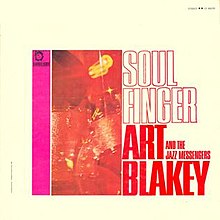
The Quarantined Jazz Voyager
The pandemic has given me time to indulge in listening to a variety of music but for this post, Soul Finger is the album I’ve chosen for this week’s edition of The Quarantined Jazz Voyager. The album was recorded by drummer Art Blakey And The Jazz Messengers recorded on May 12 & 13, 1965 in New York City and its original release date was in August of the same year on the Limelight label. The sessions were produced by Jack Tracy.
On the 2009 CD edition, Gary Bartz, whose recording debut this was, was left off the credits – he is the alto saxophonist for 5 of the 6 cuts. Lucky Thompson is only on one cut, playing soprano saxophone on Spot Session with the quartet of Blakey, John Hicks, and Victor Sproles.
A sixth cut from the Bartz sessions was used on the later Hold On, I’m Coming album. This recording was trumpeter Lee Morgan’s last recording with Art Blakey after a seven-year association; Freddie Hubbard would return to tour with Blakey’s group again in the 1980s.
Track Listing | 36:42
- Soul Finger (Freddie Hubbard, Lee Morgan) ~ 3:17
- Buh’s Bossa (Morgan) ~ 5:33
- Spot Session (Lucky Thompson) ~ 7:21
- Freedom Monday (Art Blakey) ~ 6:15
- A Quiet Thing (Fred Ebb, John Kander) ~ 6:56
- The Hub (Hubbard) ~ 7:20
- Art Blakey ~ drums
- Freddie Hubbard, Lee Morgan ~ trumpet (except on “Spot Session”)
- Gary Bartz – alto saxophone (except on “Spot Session”)
- Lucky Thompson – soprano sax (on “Spot Session”)
- John Hicks – piano
- Victor Sproles – bass
As you listen I hope you enjoy this great addition to the jazz catalog. Continue your vigilance of social distancing, wear your masks, and stay healthy. During this sabbatical from flying and investigating jazz around the globe, this Quarantined Jazz Voyager is looking forward to listening to this lineup of talented musicians and enjoy the listen and know that the world and I will be back.
More Posts: adventure,club,drums,genius,jazz,museum,music,preserving,restaurant,travel,voyager
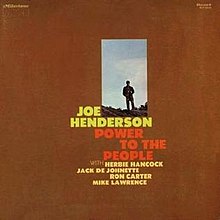
The Quarantined Jazz Voyager
POWER TO THE PEOPLE 11.12.20
As I sit socially distanced from the rest of the world ever vigilant of this pandemic, the next choice from the library is Power To The People by jazz saxophonist Joe Henderson. The album was recorded on May 23 and May 29, 1969 at Plaza Sound Studios in New York City and released on Milestone Records the same year.
Produced by Orrin Keepnews, all songs are written by Henderson except Opus One-Point-Five and Lazy Afternoon. It was his first to feature an electric instrument with Hancock playing the electric piano. This Quarantined Jazz Voyager is looking forward to listening to this lineup of talented musicians.
Track Listing | 42:27- Black Narcissus ~ 4:50
- Afro-Centric ~ 7:00
- Opus One-Point-Five (Ron Carter) ~ 4:56
- Isotope ~ 4:53
- Power to the People ~ 8:42
- Lazy Afternoon (Moross, Latouche) ~ 4:33
- Foresight and Afterthought (An Impromptu Suite in Three Movements) ~ 7:33
- Joe Henderson — tenor saxophone
- Mike Lawrence — trumpet (2, 5)
- Herbie Hancock — piano (3, 4, 6), electric piano (1, 2, 5)
- Ron Carter — bass
- Jack DeJohnette — drums
As you listen I hope you enjoy this great addition to the jazz catalog. Continue your social distancing, wear your masks and stay healthy. During this sabbatical from flying and investigating jazz around the globe, enjoy the listen and know that the world and I will be back.
More Posts: adventure,club,genius,jazz,museum,music,preserving,restaurant,saxophone,travel,voyager


